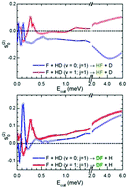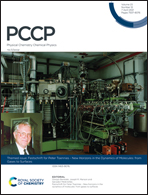The F + HD(v = 0, 1; j = 0, 1) reactions: stereodynamical properties of orbiting resonances
Abstract
The excitation functions (reaction cross-section as a function of collision energy) of the F + HD(v = 0, 1; j = 0, 1) benchmark system have been calculated in the 0.01–6 meV collision energy interval using a time-independent hyperspherical quantum dynamics methodology. Special attention has been paid to orbiting resonances, which bring about detailed information on the three-atom interaction during the reactive encounter. The location of the resonances depends on the rovibrational state of the reactants HD(v,j), but is the same for the two product channels HF + D and DF + H, as expected for these resonances that are linked to the van der Waals well at the entrance. The resonance intensities depend both on the entrance and on the exit channels. The peak intensities for the HF + D channel are systematically larger than those for DF + H. Vibrational excitation leads to an increase of the peak intensity by more than an order of magnitude, but rotational excitation has a less drastic effect. It deceases the resonance intensity of the F + HD(v = 1) reaction, but increases somewhat that of F + HD(v = 0). Polarization of the rotational angular momentum with respect to the initial velocity reveals intrinsic directional preferences in the F + HD(v = 0, 1; j = 1) reactions that are manifested in the resonance patterns. The helicities (Ω = 0, Ω = ±1) possible for j = 1 contribute to the resonances, but that from Ω ± 1 is, in general, dominant and in some cases exclusive. It corresponds to a preferential alignment of the HD internuclear axis perpendicular to the initial direction of approach and, thus, to side-on collisions. This work also shows that external preparation of the reactants, following the intrinsic preferences, would allow the enhancement or reduction of specific resonance features, and would be of great help for their eventual experimental detection.

- This article is part of the themed collection: Festschrift for Peter Toennies - New Horizons in the Dynamics of Molecules: from Gases to Surfaces


 Please wait while we load your content...
Please wait while we load your content...